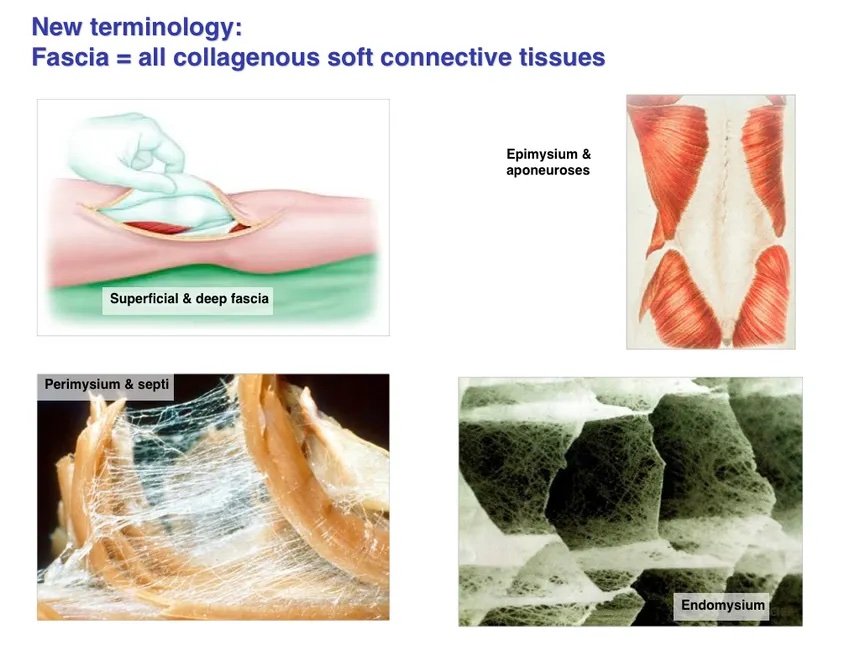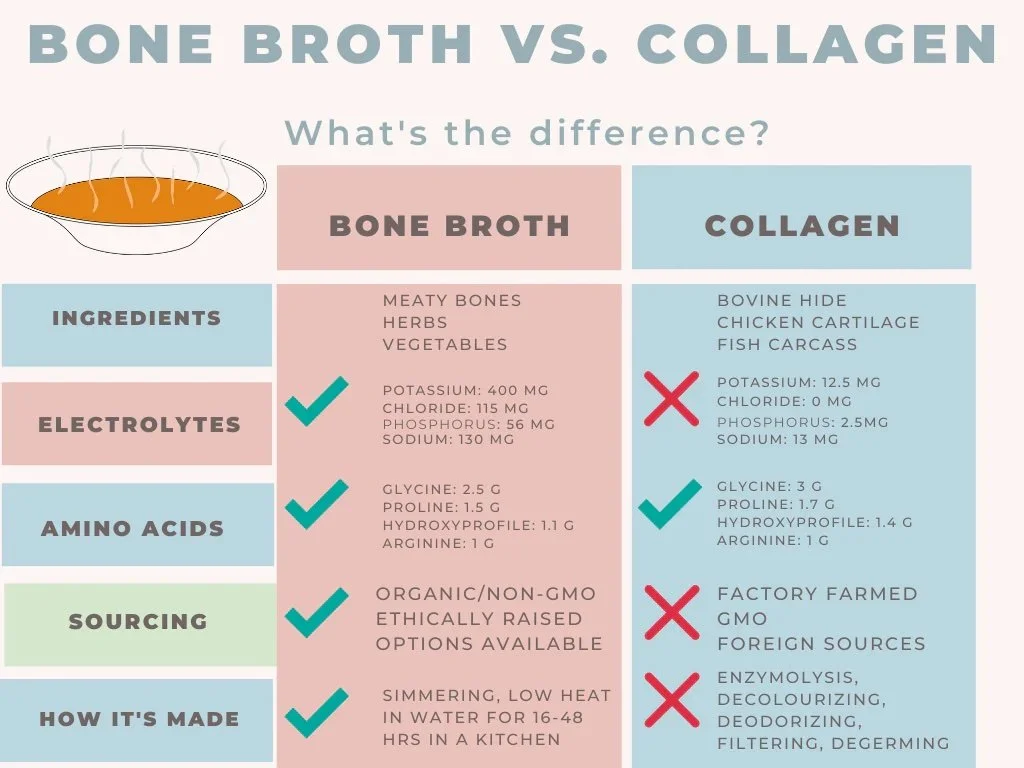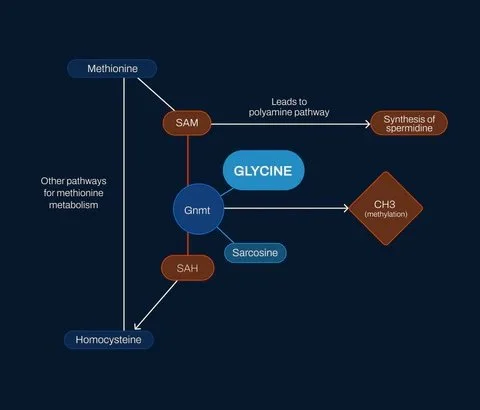Why You Should be Collagen Maxxing
Glycine is emerging as one of the shining stars among amino acids for its ability to calm the nervous system, support fascial growth, protect against glyphosate, improve glucose metabolism and extend life. The highest source of glycine comes from animal collagen - things like bone broth, gelatin, and hydrolyzed collagen powder.
In today’s article I’ll show you that incorporating these high glycine foods into your daily life can dramatically improve sleep, mood, joint pain, musculoskeletal injuries (and prevention), bone density, and reduce cardiovascular disease.
TLDR:
Collagen is the primary constituent of fascia, the structure of the body. It represents about 30% of all the protein in your body. The primary amino acid in collagen is glycine.
Among the many pernicious effects of glyphosate, the most ubiquitous herbicide, is its ability to move into the collagen structures of the body. Consuming glycine-based foods can outcompete glyphosate binding.
Glycine has been shown to increase bone mineral density, especially in the most prone population to osteoporosis - postmenopausal women.
Glycine significantly improves glucose metabolism by activating GLP-1 and insulin.
Glycine is a potent inhibitory neurotransmitter that can improve sleep and anxiety.
Glycine supplementation increases lifespan in animal models by balancing dietary methionine intake.
Collagen and fascia are essential components of the human body's connective tissue system. Collagen is protein that constitutes about one-third of all protein in the body and forms the primary structural component of connective tissues. It provides strength, elasticity, and support to all body structures.
Fascia is the network of connective tissue that envelops and supports various structures and organs in the body. It’s made primarily of collagen and serves to contain organs & tissues and reduce friction between tissues. To date, there are 28 different types of collagen identified found in skin, tendons, ligaments, bones, elastic cartilage, blood vessels, and various organs.
Fascia runs through all muscle and holds the tissues and organs of the body to our skeleton. If you’ve ever processed an animal, you’ve seen how fascia holds everything in place and compartmentalizes body structures. It’s truly an amazing substance and sometimes described as a “crystal matrix”. The above video shows an incredible endoscope moving through living fascia with the liquid tissue separating and reforming as if animated.
Bone broth contains collagen naturally broken down during slow cooking, making them easily absorbed by the body. Gelatin, derived from cooking collagen-rich animal parts and powdering them, provides a similar amino acid composition and works as a gelling agent for gummies, marshmallows, aspics and other fun things. Collagen powder offers concentrated collagen peptides more easily absorbed than gelatin but lacks the additional nutrients found in bone broth.
Bone broth provides the most comprehensive support, containing up to all 28 different types of collagen along with electrolytes. Regular consumption of these sources benefit skin elasticity, joint health, connective tissue repair, and others we’ll explore. Bone broth is considered the most efficient and natural way to consume collagen and gelatin, providing a whole food approach.
Glutamine, abundant in bone broth and collagen, is a primary fuel for small intestine cells which helps prevent leaky gut. You can think of the gut lining as a giant collagen protein network encapsulating smooth muscle, the enteric nervous system, and the gut-associated lymphoid tissue (gut immune system). For these reasons, bone broth is frequently recommended for gut health.
Glyphosate is the active ingredient in Roundup herbicide, the most common herbicide used in the USA and globally. Its so toxic that no plants can grow when its applied to them. This is why farmer’s need to buy genetically modified Roundup Ready seeds, almost everything dies except the genetically modified plants when dosed with glyphosate.
In humans, glyphosate can integrate into collagen proteins in the (illustrated above). Glyphosate molecular structure mimics glycine, an amino acid that makes up 20-25% of collagen. When glyphosate replaces glycine in the collagen structure, it disrupts the collagen's triple helix, leading to reduced elasticity and strength, decreased ability of collagen to retain water, joint pain and tendonitis, and potentially contributes to rheumatoid arthritis, osteoporosis, and skin disorders. Its my belief that glyphosate build up in collagen is a one cause of frequent tears and ruptures of ligaments, tendons and muscle tissue, especially with age.
There are other troubling features of glyphosate in humans like the disruption of the shikimate pathway. Glyphosate affects the gut microbiome by inhibiting bacteria that rely on the shikimate pathway for phenylalanine, tyrosine and tryptophan. This disruption can lead to gut dysbiosis, which may indirectly influence neurotransmitter synthesis and metabolism, including dopamine production.
The glycine in bone broth helps protect against glyphosate in several ways. Glycine competes with glyphosate for uptake in the body, reducing glyphosate absorption and storage in tissues. Glyphosate can mimic glycine in protein synthesis, leading to damaged proteins. Extra glycine from bone broth helps prevent this substitution.
Glycine supports glutathione production, a key antioxidant and detoxifier that helps remove glyphosate from the body. It has anti-inflammatory properties, helping counteract inflammation caused by glyphosate exposure. It's crucial to use bones or consume bone broth from organic, pasture-raised animals to avoid introducing additional glyphosate.
Bone broth and collagen supplementation have positive effects on bone density, particularly in postmenopausal women with age-related bone mineral density (BMD) reduction. This 12-month study showed that 5g daily intake of specific collagen peptides increased BMD in postmenopausal women. And this 4-year study found that 5g daily collagen intake significantly increased BMD with no fractures reported. It appears its the glycine and proline contained in collagen that is supporting calcium retention in bones. To get the equivalent of 5g of glycine in bone broth you’d need about 15 oz or 20g of collagen powder.
Glycine has remarkable beneficial effects on glucose metabolism. Glycine supplementation can improve insulin sensitivity in insulin-resistant individuals. Higher glycine intake is associated decreased type 2 diabetes risk. When ingested with glucose, glycine attenuated the plasma glucose response by over 50% compared to glucose alone. The mechanism of actions appears to be through the secretion of GLP-1 in small intestine (like Ozempic) and modulation of pancreatic insulin production.
Glycine is the second most potent inhibitory (calming) neurotransmitter in the central nervous system, after GABA (gamma-aminobutyric acid). Both GABA and glycine work synergistically with each other to calm the brain to create a sense of relaxation. With bone broth being 20-25% glycine, its excellent to have 1-2 hours before sleep.
Glycine helps reduce the time it takes to fall asleep. Studies show glycine increases overall sleep efficiency. Glycine positively affects non-REM sleep phases, leading to more restorative sleep.
If you have anxiety, the glycine in bone broth can help to calm neural activity and reduce excitability. This inhibitory effect can contribute to a sense of relaxation and ease.
In rare cases, individuals with glutamate sensitivity can react poorly to the high amounts of glutamine in bone broth and collagen powder. Glutamine readily converts to glutamate, the primary excitatory neurotransmitter in the brain. There’s a delicate balance and bidirectional conversion between GABA and glutamate in the brain to manage wakefulness and sleep. Glutamate sensitive individuals have trouble converting glutamate into GABA leading to higher excitability. Using pure glycine powder is an effective workaround.
Worth noting that if you fall into the category of anxiety, poor sleep, and easily overstimulated, supplementing GABA with your glycine is a powerful combination.
Glycine plays a crucial role in balancing methionine metabolism and promoting longevity, partly through its ability to lower homocysteine levels.
Glycine interacts with the methionine cycle through the enzyme glycine N-methyltransferase (GNMT), which helps clear excess methionine from the body. This process is important because excess methionine can lead to elevated homocysteine levels, which are associated with increased oxidative stress and cardiovascular risk. You can easily test your homocysteine level through Marek. The ideal level is 5-7.2 umol/L. Also interesting is that elevated homocysteine levels correlate with shortened sleep duration.
In rats, a 10% glycine diet increased lifespan by over 20% in mice. This life-extending effect is believed to be partly due to glycine's ability to mimic methionine restriction. By helping to clear excess methionine and lower homocysteine levels, glycine supports a more balanced metabolic state that is conducive to healthy aging.
To Recap
Aim to drink about 12-16oz bone broth daily or 20g of collagen peptides to get the 5g/day of glycine
Making bone broth yourself with organic grass-fed bones is the best
For convenience I like organic Roli Roti Beef Bone Broth and Perfect Supplements Beef Collagen which has been tested for heavy metals and glyphosate.
If you can’t tolerate that due to glutamate sensitivity, use pure glycine powder mixed into a juice or milk
To your health,
Jonathan
This is for informational purposes only and should not replace professional medical advice. Consult with your physician or other health care professional if you have any concerns or questions about your health.








